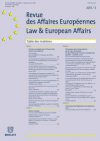David Restrepo Amariles et Nathan Genicot ont publié un article, dans le cadre d’un numéro spécial de la Revue des affaires européennes consacré à l’Etat de droit au sein de l’UE, portant sur le recours à des indicateurs pour évaluer le respect de l’Etat de droit par les Etats membres.
The increasing number of violations to the rule of law by Member States has put legal indicators into the agenda of the European Union (EU). This article analyses the issues surrounding the potential implementation of an indicator measuring the rule of law within the EU. It argues that such an indicator would be compatible with the governance structure of the EU and has the potential to help fulfilling certain policy objectives irrespectively of who the issuer is. However, it also raises concerns about the relevance and suitability of using this tool to fight breaches to the rule of law in a contested institutional setting. The article is divided in two parts. First, it investigates the institutional context leading to the idea of issuing a rule of law indicator and places this initiative as part of the EU’s long-standing practice of using indicators as tools of governance. Second, it examines the form that a EU rule of law indicator could take. For this purpose, we rely on several instruments of the European legal framework and on existing international rule of law indicators. The article concludes by raising awareness about the negative effects that an indicator driven strategy for the rule of law could have on the political legitimacy of the EU.
N. Genicot et D. Restrepo Amariles, “Assurer l’Etat de droit dans l’Union européenne : vers une approche quantitative ?”, RAE, 2019/1, p. 75
La revue est notamment disponible sur Jurisquare.





